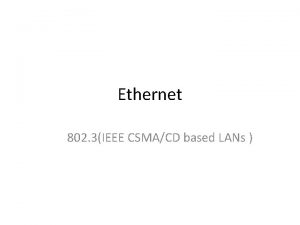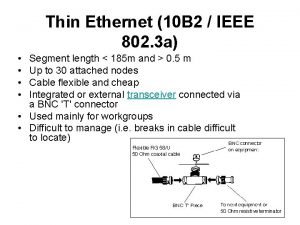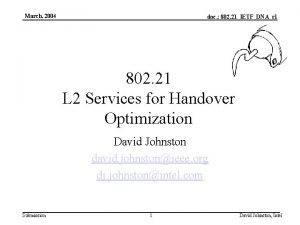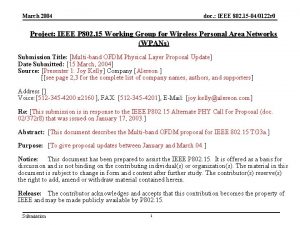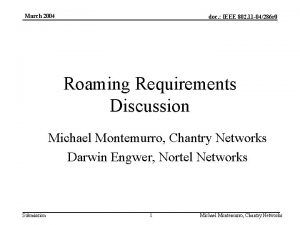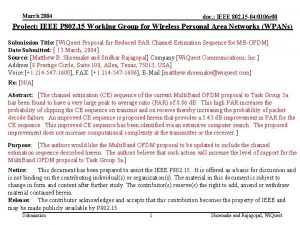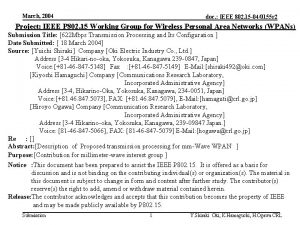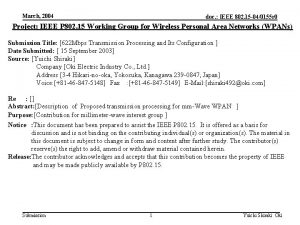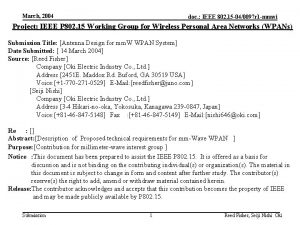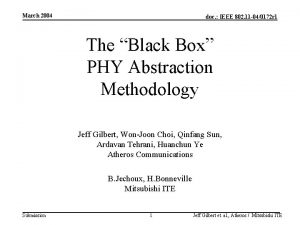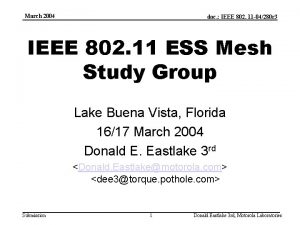March 2004 doc IEEE 802 11 040243 r











![May 2004 doc. : IEEE 802. 11 -04/0243 r 2 References [1] IEEE 802. May 2004 doc. : IEEE 802. 11 -04/0243 r 2 References [1] IEEE 802.](https://slidetodoc.com/presentation_image_h2/96db02d0f1bff4e881189429cf1bf78c/image-12.jpg)

- Slides: 13

March 2004 doc. : IEEE 802. 11 -04/0243 r 2 Turbo Codes for IEEE 802. 11 n May 2004 Marie-Helene Hamon, Vincent Le Nir, Marilyne Helard France Telecom R&D, Rennes, France Brian Edmonston, i. Coding (contact: mhelene. hamon@rd. francetelecom. com) Submission 1 Brian Edmonston, i. Coding

May 2004 doc. : IEEE 802. 11 -04/0243 r 2 Contents • • • TC for 802. 11 n Duo-Binary Turbo Codes Simulation assumptions Results Conclusion Submission 2 Brian Edmonston, i. Coding

March 2004 doc. : IEEE 802. 11 -04/0243 r 2 Turbo Codes: Iterative FEC for 802. 11 n • Powerful error correcting codes are considered in 802. 11 n discussions • Turbo Codes, and more specifically Duo-Binary Turbo Codes [4], the latest generation of convolutional turbo codes, have been introduced in contribution IEEE 802. 11 -04/003 [1] at the last meeting • The numerous advantages of these Turbo Codes, including the large performance gains enabled and their high flexibility, have been demonstrated in this previous contribution. This presentation will focus on the performance of these Turbo Codes in 802. 11 a PHY reference model. Submission 3 Brian Edmonston, i. Coding

May 2004 doc. : IEEE 802. 11 -04/0243 r 2 Duo-Binary Turbo Codes • Very good performance: better than LDPC codes - for any code rate - for any block size <10000 bits - for any BER >10 -9 - for any associated modulation • Highly flexible solution: Duo-Binary Turbo Codes adjust easily to any code rate and block size, resulting in a better granularity Submission 4 Brian Edmonston, i. Coding

May 2004 doc. : IEEE 802. 11 -04/0243 r 2 Simulation assumptions • Simulation chain based on 802. 11 a PHY model • Perfect channel estimation, synchronization and front end (SISO configuration) • Channels - AWGN channel - BRAN A channel Submission 5 Brian Edmonston, i. Coding

May 2004 doc. : IEEE 802. 11 -04/0243 r 2 Simulation Assumptions • The turbo code and the 802. 11 a convolutional code both simulated, with packet size 200 bytes, code rates ½ and ¾ • Turbo Codes - 8 -state Duo-Binary Convolutional Turbo Codes - Max-Log-MAP decoding, 8 iterations • Convolutional Code - Viterbi decoding algorithm Submission 6 Brian Edmonston, i. Coding

May 2004 doc. : IEEE 802. 11 -04/0243 r 2 Simulation Results: AWGN 2 to 2. 5 d. B gain at PER 1% Submission 7 Brian Edmonston, i. Coding

May 2004 doc. : IEEE 802. 11 -04/0243 r 2 Simulation Results: BRAN A 1. 8 to 2. 4 d. B gain at PER 1% Submission 8 Brian Edmonston, i. Coding

May 2004 doc. : IEEE 802. 11 -04/0243 r 2 Turbo Codes and MIMO • MIMO techniques employed: Space-Time Block Coding (2 x 1) Alamouti scheme • Channel model: uncorrelated Rayleigh fading channels Submission 9 Brian Edmonston, i. Coding

May 2004 doc. : IEEE 802. 11 -04/0243 r 2 Simulation results: STBC 2 x 1 Submission 10 Brian Edmonston, i. Coding

May 2004 doc. : IEEE 802. 11 -04/0243 r 2 Conclusions • Turbo Codes, and more specifically Duo-Binary Turbo Codes, provide large performance gains in 802. 11 a context, as well as combined with MIMO techniques • Their flexibility is an important advantage, allowing a finer granularity in block size and coding rate (cf [1]) • Incorporated in a complete system, these Turbo Codes will represent a significant advantage to achieve 802. 11 n goals. Submission 11 Brian Edmonston, i. Coding
![May 2004 doc IEEE 802 11 040243 r 2 References 1 IEEE 802 May 2004 doc. : IEEE 802. 11 -04/0243 r 2 References [1] IEEE 802.](https://slidetodoc.com/presentation_image_h2/96db02d0f1bff4e881189429cf1bf78c/image-12.jpg)
May 2004 doc. : IEEE 802. 11 -04/0243 r 2 References [1] IEEE 802. 11 -04/003, "Turbo Codes for 802. 11 n", France Telecom R&D, ENST Bretagne, i. Coding Technology, Turbo. Concept, January 2004. [2] C. Berrou, A. Glavieux, P. Thitimajshima, "Near Shannon limit errorcorrecting coding and decoding: Turbo Codes", ICC 93, vol. 2, pp. 1064 -1070, May 93. [3] C. Berrou, "The ten-year-old turbo codes are entering into service", IEEE Communications Magazine, vol. 41, pp. 110 -116, August 03. [4] C. Berrou, M. Jezequel, C. Douillard, S. Kerouedan, "The advantages of nonbinary turbo codes", Proc IEEE ITW 2001, pp. 61 -63, Sept. 01. [5] TS 25. 212 : 3 rd Generation Partnership Project (3 GPP) ; Technical Specification Group (TSG) ; Radio Access Network (RAN) ; Working Group 1 (WG 1); "Multiplexing and channel coding (FDD)". October 1999. [6] EN 301 790 : Digital Video Broadcasting (DVB) "Interaction channel or satellite distribution systems". December 2000. [7] EN 301 958 : Digital Video Broadcasting (DVB) "Specification of interaction channel for digital terrestrial TV including multiple access OFDM". March 2002. Submission 12 Brian Edmonston, i. Coding

May 2004 doc. : IEEE 802. 11 -04/0243 r 2 BRAN A Channel • SISO WLAN channel model • Delay profile model, typical office environment, NLOS • 50 ns rms delay spread • 18 taps, max delay spread 390 ns Submission 13 Brian Edmonston, i. Coding












